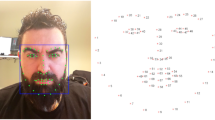Abstract
It is well-known that, during shape extraction, enrolling an appropriate shape constraint model could effectively improve locating accuracy. In this paper, a novel deformable shape model, Sparse Representation Shape Models (SRSM), is introduced. Rather than following commonly utilized statistical shape constraints, our model constrains shape appearance based on a morphological structure, the convex hull of aligned training samples, i.e., only shapes that could be linearly represented by aligned training samples with the sum of coefficients equal to one, are defined as qualified. This restriction strictly controls shape deformation modes to reduce extraction errors and prevent extremely poor outputs. This model is realized based on sparse representation, which ensures during shape regularization the maximum valuable shape information could be reserved. Besides, SRSM is interpretable and hence helpful to further understanding applications, such as face pose recognition. The effectiveness of SRSM is verified on two publicly available face image datasets, the FGNET and the FERET.

Similar content being viewed by others
Notes
Before processing, each input shape must be aligned with the mean of training samples to unify coordinate system.
References
The FGNET talking face video. http://personalpages.manchester.ac.uk/staff/timothy.f.cootes/data/talking_face/talking_face.html
Alvarez, L., Baumela, L., Henríquez, P., Márquez-Neila, P.: Morphological snakes. In: Proceedings of IEEE Computer Society Conference on Computer Vision and Pattern Recognition, pp. 2197–2202 (2010)
Amaldi, E., Kann, V.: On the approximability of minimizing nonzero variables or unsatisfied relations in linear systems. Theor. Comput. Sci. 209(1–2), 237–260 (1998)
Belhumeur, P., Hespanha, J., Kriegman, D.: Eigenfaces vs. fisherfaces: recognition using class specific linear projection. IEEE Trans. Pattern Anal. Mach. Intell. 19(7), 711–720 (1997)
Boyd, S., Vandenberghe, L.: Convex Optimization. Cambridge University Press, Cambridge (2004)
Candès, E., Eldar, Y., Needell, D., Randall, P.: Compressed sensing with coherent and redundant dictionaries. Appl. Comput. Harmon. Anal. 31(1), 1–21 (2010)
Candès, E., Romberg, J.: L1-magic: recovery of sparse signals via convex programming (2005). http://users.ece.gatech.edu/~justin/l1magic/downloads/l1magic.pdf
Chen, C., Zhao, M., Li, S.Z., Bu, J.: Parameter optimization for active shape models. In: Proceedings of Asian Conference on Computer Vision (2004)
Chin, R.T., Dyer, C.R.: Model-based recognition in robot vision. ACM Comput. Surv. 18(1), 67–108 (1986)
Cootes, T., Taylor, C.: A mixture model for representing shape variation. Image Vis. Comput. 17(8), 567–573 (1999)
Cootes, T., Taylor, C.: Statistical models of appearance for computer vision. Technical report, University of Manchester (2004)
Cootes, T., Taylor, C., Cooper, D., Graham, J.: Training models of shape from sets of examples. In: Proceedings of British Machine Vision Conference, pp. 9–18 (1992)
Cootes, T.F., Taylor, C.J., Cooper, D.H., Graham, J.: Active shape models-their training and application. Comput. Vis. Image Underst. 61(1), 38–59 (1995)
Donoho, D.: Neighborly polytopes and sparse solution of underdetermined linear equations. Technical Report, Stanford University (2005)
Elad, M.: Sparse and Redundant Representations: From Theory to Applications in Signal and Image Processing. Springer, Berlin (2010)
Erbou, S., Vester-Christensen, M., Larsen, R., Christensen, L.B., Ersbøll, B.K.: Comparison of sparse point distribution models. Mach. Vis. Appl. 21(6), 999–1008 (2010)
Huang, X., Metaxas, D.: Metamorphs: deformable shape and appearance models. IEEE Trans. Pattern Anal. Mach. Intell. 30(8), 1444–1459 (2007)
Li, Y., Feng, J.: Sparse representation shape model. In: Proceedings of International Conference on Image Processing, pp. 2733–2736
Li, Y., Feng, J.: Frontal face synthesizing according to multiple non-frontal inputs and its application in face recognition. Neurocomputing 91, 77–85 (2012)
Matthews, I., Baker, S.: Active appearance models revisited. Int. J. Comput. Vis. 60, 135–164 (2004)
Milborrow, S., Nicolls, F.: Locating facial features with an extended active shape model. In: Proceedings of European Conference on Computer Vision, pp. 504–513 (2008)
Phillips, P., Moon, H., Rizvi, S., Rauss, P.: The feret evaluation methodology for face recognition algorithms. IEEE Trans. Pattern Anal. Mach. Intell. 22(10), 1090–1104 (2000)
Phillips, P., Wechsler, H., Huang, J., Rauss, P.: The feret database and evaluation procedure for face recognition algorithms. Image Vis. Comput. 16(5), 295–306 (1998)
Sjöstrand, K., Stegmann, M.B., Larsen, R.: Sparse principal component analysis in medical shape modeling. In: Proceedings of International Symposium on Medical Imaging (2006)
Sozou, P.D., Cootes, T.F., Taylor, C.J.: A non-linear generalisation of point distribution models using polynomial regression. In: Proceedings of British Machine Vision Conference, pp. 397–406 (1994)
Sukno, F.M., Ordás, S., Butakoff, C., Cruz, S., Frangi, A.F.: Active shape models with invariant optimal features: application to facial analysis. IEEE Trans. Pattern Anal. Mach. Intell. 29(7), 1105–1117 (2007)
Sundaramoorthi, G., Soatto, S., Yezzi, A.: Curious snakes: a minimum latency solution to the cluttered background problem in active contours. In: Proceedings of IEEE Computer Society Conference on Computer Vision and Pattern Recognition, pp. 2855–2862 (2010)
Szeliski, R.: Computer Vision: Algorithms and Applications. Springer, Berlin (2010)
Turk, M., Pentland, A.: Eigenfaces for recognition. J. Cogn. Neurosci. 3(1), 71–86 (1991)
Viola, P., Jones, M.: Robust real-time face detection. Int. J. Comput. Vis. 57(2), 137–154 (2004)
Wright, J., Yang, A., Ganesh, A., Sastry, S., Ma, Y.: Robust face recognition via sparse representation. IEEE Trans. Pattern Anal. Mach. Intell. 31(2), 210–227 (2009)
Yang, A., Sastry, S., Ganesh, A., Ma, Y.: Fast l1-minimization algorithms and an application in robust face recognition: a review. In: IEEE International Conference on Image Processing, pp. 1849–1852 (2010)
Zhou, Y., Zhang, W., Tang, X., Shum, H.: A bayesian mixture model for multi-view face alignment. In: Proceedings of IEEE Computer Society Conference on Computer Vision and Pattern Recognition, vol. 2, pp. 741–746 (2005)
Author information
Authors and Affiliations
Corresponding author
Additional information
This work was partially supported by the National Basic Research Program of China (2011CB302400) and the National Natural Science Foundation of China (61173032).
Rights and permissions
About this article
Cite this article
Li, Y., Feng, J., Meng, L. et al. Sparse Representation Shape Models. J Math Imaging Vis 48, 83–91 (2014). https://doi.org/10.1007/s10851-012-0394-3
Published:
Issue Date:
DOI: https://doi.org/10.1007/s10851-012-0394-3




